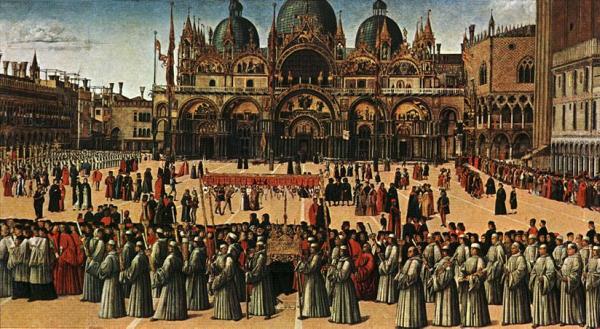Giovanni Bellini Gallery
The Venetian Republic developed under the authority of the Doge, a name derived from the Latin dux (head). After a complex series of balloting by 41 senior statesmen, the election of a new doge was heralded by the ringing of bells. If the choice proved popular, widespread rejoicing would follow, as well as a coronation ceremony.
From 1173 to 1797, a sumptuous ceremony expressed all that constituted the grandeur of Venice. As the Republic had supported Pope Alexander III in his struggle against the emperor Frederick Barbarossa, the Pope gave the Doge a ring as a "symbol of your empire over the sea". To commemorate this, each year on Ascension Day, the Doge, robed in cloth of gold, paraded ceremoniously in his galley, the Bucintoro, and cast a ring into the sea with the words "We espouse thee, O Sea, in token of our perpetual sovereignty" Following the coronation would be a mass in San Marco
Venice maintained its independence and the pre-eminence on the commerce with
the Middle and Far East, till 1797 when Napoleon gave the City to the Austrian
Empire. The myth of the wedding of Venice to the sea was the glorification
and the statement of all those values that spurred the ancient Venetian
people to enlarge and make great their own small country of the lagoons, maintaining alive their peculiar traditions and their autonomy.
After the ceremony, the doge would reside at the Ducal Palace, one of the most famous buildings in Venice, with its mixture of Western Gothic and Eastern influences. "The whole scheme of columned and pointed arcades, with its combination of carved capitals and long horizontal lines of open tracery, is of that unique design which can only be termed Venetian Gothic."

viewer |
|
|
| Altarpiece |
Piazza San Marco |
| Leonardo Loredan |
| Feast of the Gods |
| Fortitude |
| Joerg Fugger |
| Virgin and Child |
Biography
Bulletin Board
Renowned Art
(home)
Giovanni Bellini was a Venetian painter. His focus was on religious subjects. His most important contribution to art lay in his experimentation with the use of color and atmosphere in oil painting. Through the use of clear, slow-drying oil paints, Giovanni created deep, rich colors and detailed shadings. His sumptuous coloring and fluent, atmospheric landscapes had a great effect on Venetian painting school. When he died, he was chief painter to the state of Venice.
all artists, with thumbnails: by birth year | alphabetically
all artists: by birth year | alphabetically
artists born in the 13th 14th 15th 16th 17th 18th 19th 20th century